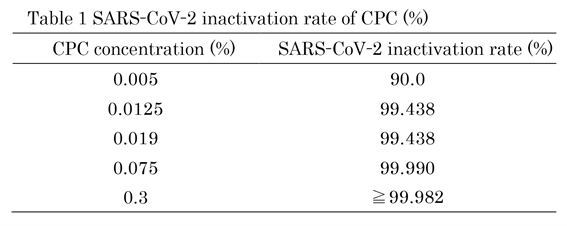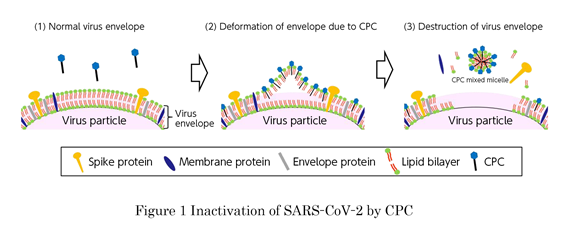October 25, 2021
Cetylpyridinium chloride hydrate (CPC) confirmed to have an action inactivating SARS-CoV-2
Taisho Pharmaceutical Co., Ltd. [Head office: Toshima-ku, Tokyo, President: Shigeru Uehara] (hereinafter, Taisho Pharmaceutical) and a research team at Kumamoto University with principal members Professor Hirofumi Kai of the Department of Molecular Medicine and Professor Shogo Misumi of the Department of Environmental and Molecular Health Sciences, both of the Faculty of Life Sciences, Kumamoto University (hereinafter, Kumamoto University) announce that, in an in vitro study (test-tube experiment) conducted as joint research, they have confirmed that exposure to the antimicrobial cetylpyridinium chloride hydrate (CPC) at concentrations ≥ 0.0125% for 5 minutes causes ≥ 99% inactivation of SARS-CoV-2.
Below, we explain the details of the research.
Action of cetylpyridinium chloride hydrate (CPC) inactivating SARS-CoV-2
In the in vitro study conducted as joint research by Taisho Pharmaceutical and Kumamoto University, the action of CPC inactivating SARS-CoV-2 (2019 nCoV/Japan/TY/WK 521/2020) was verified by a method conforming to the Efficacy Assessment of Disinfecting Substances Alternative to Alcohol Against SARS-CoV-2 (Final Report) * (June 2020, National Institute of Technology and Evaluation). The SARS-CoV-2 solution and CPC solution were mixed in a 1:1 ratio and left for 5 minutes to allow the action to occur, and the extent to which infectious virus had decreased was assessed, and as a result, it was confirmed that exposure to CPC at concentrations ≥ 0.0125% inactivates (causes loss of infectivity) of ≥ 99% of SARS-CoV-2 (Table 1).

CPC is known to exert an antimicrobial action by destroying bacterial cell membrane consisting of lipid bilayer. Since the envelope of SARS-CoV-2 has a lipid bilayer structure, it is likely that CPC inactivates SARS-CoV-2 by destroying the envelope (Figure 1).

The genetic information of the SARS-CoV-2 has recently mutated, and epidemic spread of mutant viruses with altered spike protein structures has been observed, but these mutant viruses have similar envelopes. We will continue to pursue research into the novel actions of CPC.
- Efficacy Assessment of Disinfecting Substances Alternative to Alcohol Against SARS-CoV-2 (Final Report)
https://www.nite.go.jp/data/000111315.pdf
